Early Childhood Leadership: Styles, Characters, and Analysis
VerifiedAdded on 2022/08/21
|10
|2716
|19
Report
AI Summary
This report delves into the multifaceted realm of early childhood leadership, examining various leadership styles and their impact on educational environments. It explores autocratic, democratic, and laissez-faire leadership styles, highlighting their strengths and weaknesses within the context of early childhood education. The report also investigates transformational and pedagogical leadership approaches, emphasizing their roles in fostering positive organizational culture, motivating teachers, and enhancing the learning process for children. Through analysis and examples, the report provides a comprehensive overview of effective leadership strategies in early childhood settings, emphasizing the importance of clear goals, collaboration, and intercultural understanding to ensure children's right to education and promote their development.
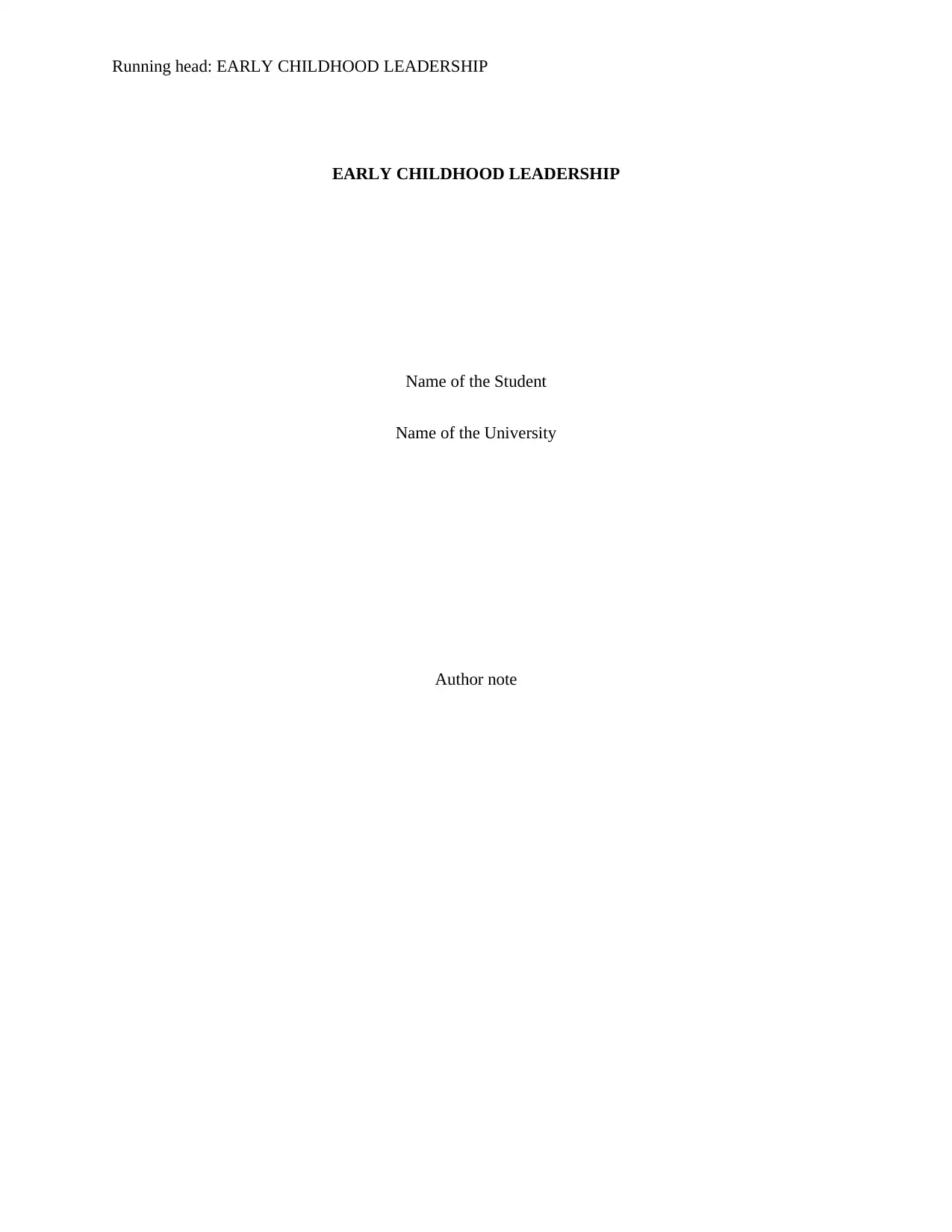
Running head: EARLY CHILDHOOD LEADERSHIP
EARLY CHILDHOOD LEADERSHIP
Name of the Student
Name of the University
Author note
EARLY CHILDHOOD LEADERSHIP
Name of the Student
Name of the University
Author note
Paraphrase This Document
Need a fresh take? Get an instant paraphrase of this document with our AI Paraphraser
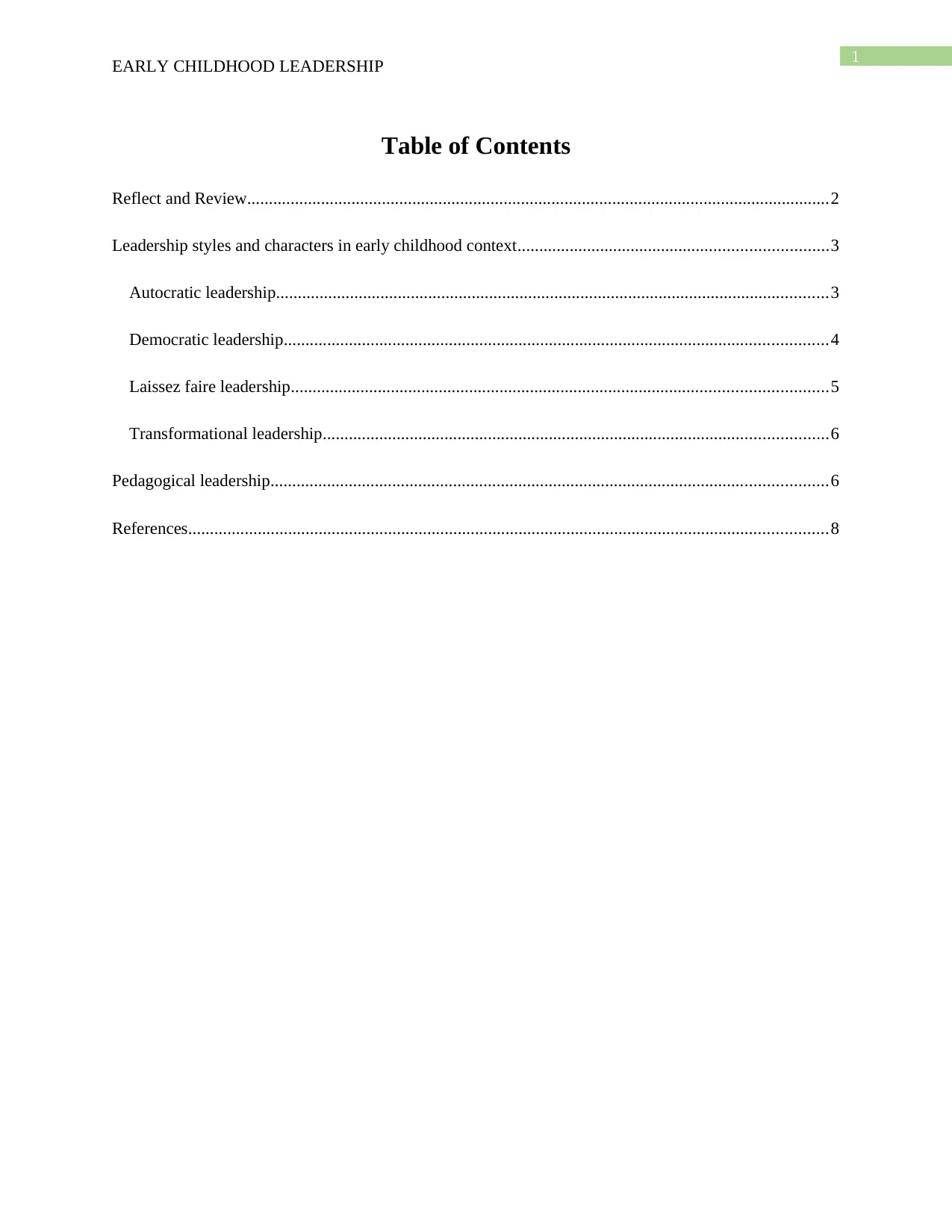
1
EARLY CHILDHOOD LEADERSHIP
Table of Contents
Reflect and Review......................................................................................................................................2
Leadership styles and characters in early childhood context.......................................................................3
Autocratic leadership...............................................................................................................................3
Democratic leadership.............................................................................................................................4
Laissez faire leadership...........................................................................................................................5
Transformational leadership....................................................................................................................6
Pedagogical leadership................................................................................................................................6
References...................................................................................................................................................8
EARLY CHILDHOOD LEADERSHIP
Table of Contents
Reflect and Review......................................................................................................................................2
Leadership styles and characters in early childhood context.......................................................................3
Autocratic leadership...............................................................................................................................3
Democratic leadership.............................................................................................................................4
Laissez faire leadership...........................................................................................................................5
Transformational leadership....................................................................................................................6
Pedagogical leadership................................................................................................................................6
References...................................................................................................................................................8
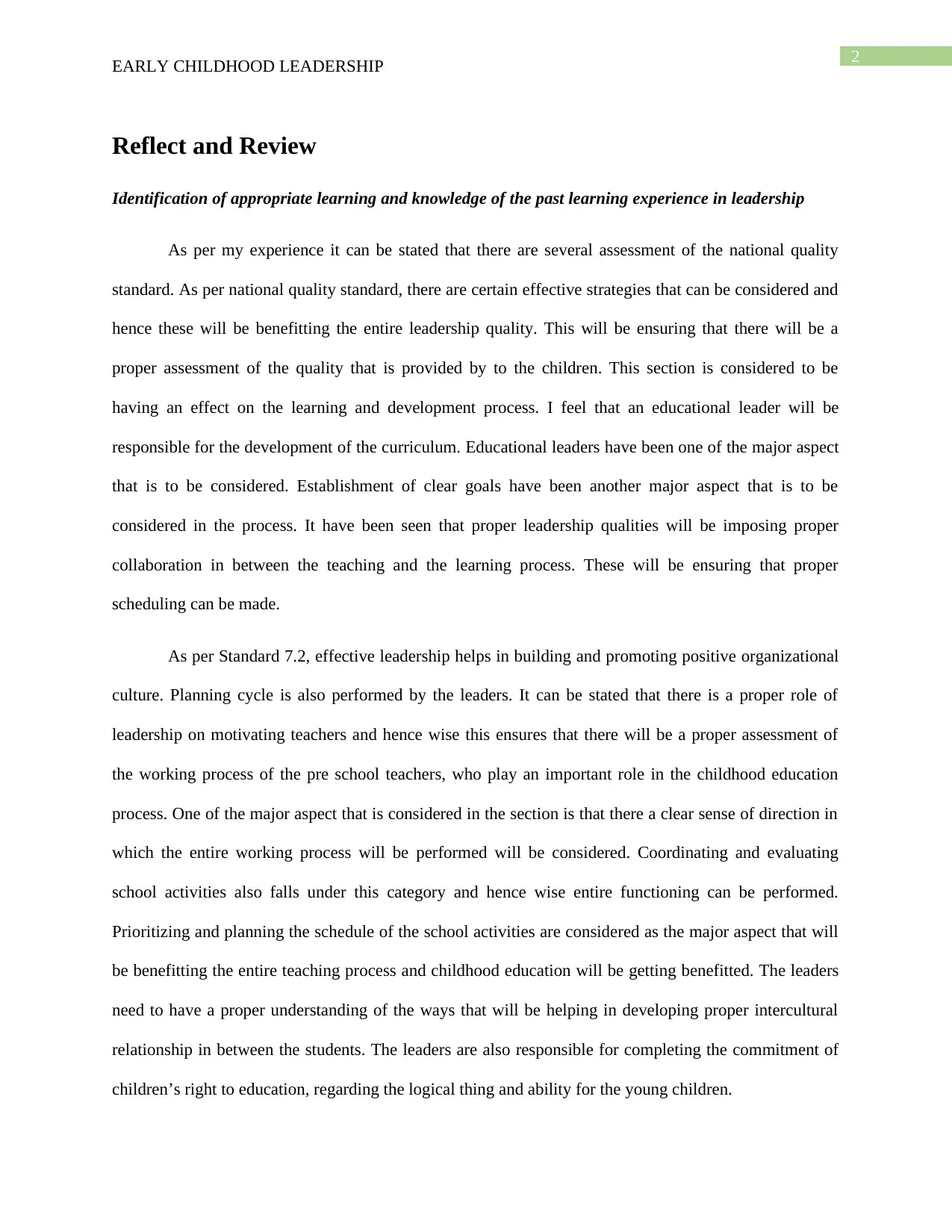
2
EARLY CHILDHOOD LEADERSHIP
Reflect and Review
Identification of appropriate learning and knowledge of the past learning experience in leadership
As per my experience it can be stated that there are several assessment of the national quality
standard. As per national quality standard, there are certain effective strategies that can be considered and
hence these will be benefitting the entire leadership quality. This will be ensuring that there will be a
proper assessment of the quality that is provided by to the children. This section is considered to be
having an effect on the learning and development process. I feel that an educational leader will be
responsible for the development of the curriculum. Educational leaders have been one of the major aspect
that is to be considered. Establishment of clear goals have been another major aspect that is to be
considered in the process. It have been seen that proper leadership qualities will be imposing proper
collaboration in between the teaching and the learning process. These will be ensuring that proper
scheduling can be made.
As per Standard 7.2, effective leadership helps in building and promoting positive organizational
culture. Planning cycle is also performed by the leaders. It can be stated that there is a proper role of
leadership on motivating teachers and hence wise this ensures that there will be a proper assessment of
the working process of the pre school teachers, who play an important role in the childhood education
process. One of the major aspect that is considered in the section is that there a clear sense of direction in
which the entire working process will be performed will be considered. Coordinating and evaluating
school activities also falls under this category and hence wise entire functioning can be performed.
Prioritizing and planning the schedule of the school activities are considered as the major aspect that will
be benefitting the entire teaching process and childhood education will be getting benefitted. The leaders
need to have a proper understanding of the ways that will be helping in developing proper intercultural
relationship in between the students. The leaders are also responsible for completing the commitment of
children’s right to education, regarding the logical thing and ability for the young children.
EARLY CHILDHOOD LEADERSHIP
Reflect and Review
Identification of appropriate learning and knowledge of the past learning experience in leadership
As per my experience it can be stated that there are several assessment of the national quality
standard. As per national quality standard, there are certain effective strategies that can be considered and
hence these will be benefitting the entire leadership quality. This will be ensuring that there will be a
proper assessment of the quality that is provided by to the children. This section is considered to be
having an effect on the learning and development process. I feel that an educational leader will be
responsible for the development of the curriculum. Educational leaders have been one of the major aspect
that is to be considered. Establishment of clear goals have been another major aspect that is to be
considered in the process. It have been seen that proper leadership qualities will be imposing proper
collaboration in between the teaching and the learning process. These will be ensuring that proper
scheduling can be made.
As per Standard 7.2, effective leadership helps in building and promoting positive organizational
culture. Planning cycle is also performed by the leaders. It can be stated that there is a proper role of
leadership on motivating teachers and hence wise this ensures that there will be a proper assessment of
the working process of the pre school teachers, who play an important role in the childhood education
process. One of the major aspect that is considered in the section is that there a clear sense of direction in
which the entire working process will be performed will be considered. Coordinating and evaluating
school activities also falls under this category and hence wise entire functioning can be performed.
Prioritizing and planning the schedule of the school activities are considered as the major aspect that will
be benefitting the entire teaching process and childhood education will be getting benefitted. The leaders
need to have a proper understanding of the ways that will be helping in developing proper intercultural
relationship in between the students. The leaders are also responsible for completing the commitment of
children’s right to education, regarding the logical thing and ability for the young children.
⊘ This is a preview!⊘
Do you want full access?
Subscribe today to unlock all pages.

Trusted by 1+ million students worldwide
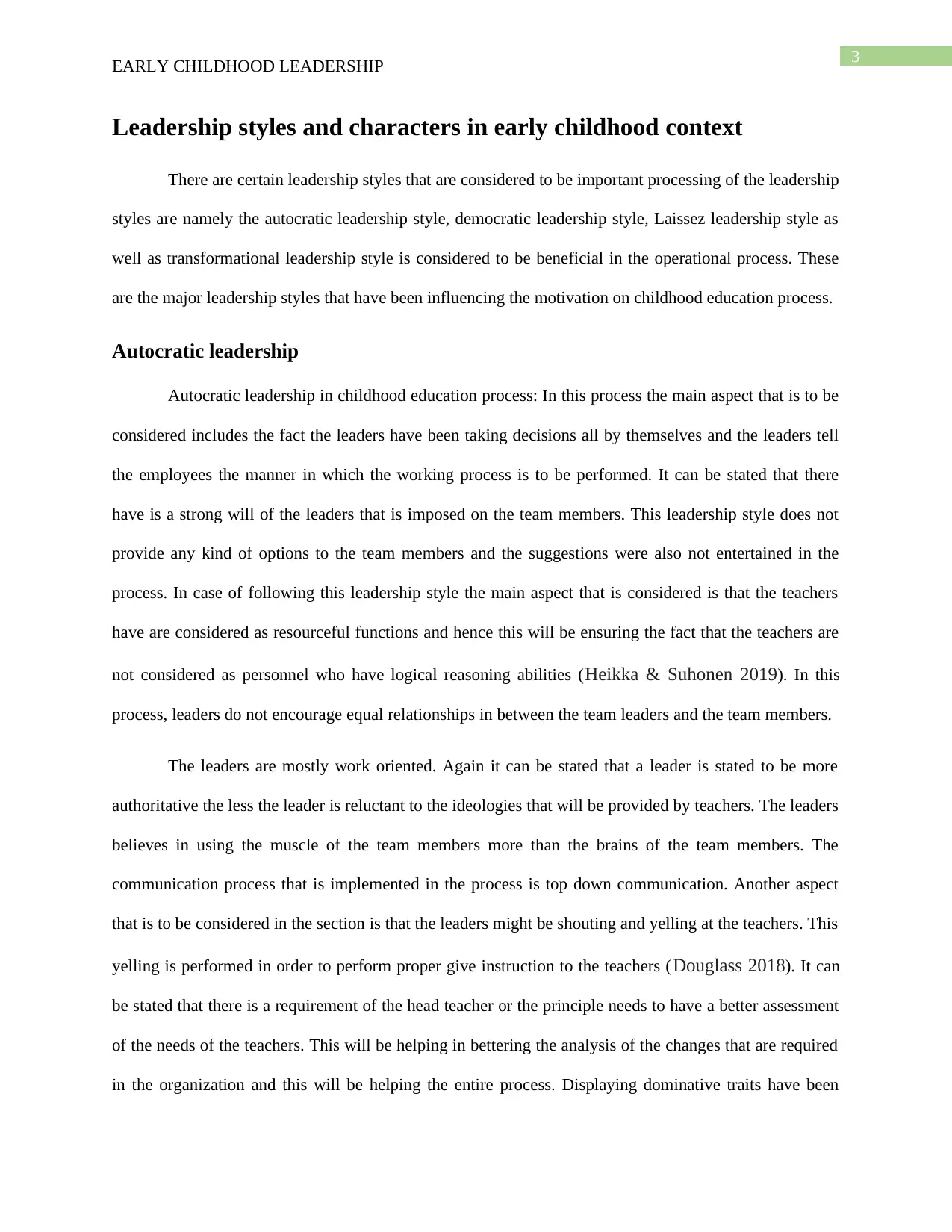
3
EARLY CHILDHOOD LEADERSHIP
Leadership styles and characters in early childhood context
There are certain leadership styles that are considered to be important processing of the leadership
styles are namely the autocratic leadership style, democratic leadership style, Laissez leadership style as
well as transformational leadership style is considered to be beneficial in the operational process. These
are the major leadership styles that have been influencing the motivation on childhood education process.
Autocratic leadership
Autocratic leadership in childhood education process: In this process the main aspect that is to be
considered includes the fact the leaders have been taking decisions all by themselves and the leaders tell
the employees the manner in which the working process is to be performed. It can be stated that there
have is a strong will of the leaders that is imposed on the team members. This leadership style does not
provide any kind of options to the team members and the suggestions were also not entertained in the
process. In case of following this leadership style the main aspect that is considered is that the teachers
have are considered as resourceful functions and hence this will be ensuring the fact that the teachers are
not considered as personnel who have logical reasoning abilities (Heikka & Suhonen 2019). In this
process, leaders do not encourage equal relationships in between the team leaders and the team members.
The leaders are mostly work oriented. Again it can be stated that a leader is stated to be more
authoritative the less the leader is reluctant to the ideologies that will be provided by teachers. The leaders
believes in using the muscle of the team members more than the brains of the team members. The
communication process that is implemented in the process is top down communication. Another aspect
that is to be considered in the section is that the leaders might be shouting and yelling at the teachers. This
yelling is performed in order to perform proper give instruction to the teachers (Douglass 2018). It can
be stated that there is a requirement of the head teacher or the principle needs to have a better assessment
of the needs of the teachers. This will be helping in bettering the analysis of the changes that are required
in the organization and this will be helping the entire process. Displaying dominative traits have been
EARLY CHILDHOOD LEADERSHIP
Leadership styles and characters in early childhood context
There are certain leadership styles that are considered to be important processing of the leadership
styles are namely the autocratic leadership style, democratic leadership style, Laissez leadership style as
well as transformational leadership style is considered to be beneficial in the operational process. These
are the major leadership styles that have been influencing the motivation on childhood education process.
Autocratic leadership
Autocratic leadership in childhood education process: In this process the main aspect that is to be
considered includes the fact the leaders have been taking decisions all by themselves and the leaders tell
the employees the manner in which the working process is to be performed. It can be stated that there
have is a strong will of the leaders that is imposed on the team members. This leadership style does not
provide any kind of options to the team members and the suggestions were also not entertained in the
process. In case of following this leadership style the main aspect that is considered is that the teachers
have are considered as resourceful functions and hence this will be ensuring the fact that the teachers are
not considered as personnel who have logical reasoning abilities (Heikka & Suhonen 2019). In this
process, leaders do not encourage equal relationships in between the team leaders and the team members.
The leaders are mostly work oriented. Again it can be stated that a leader is stated to be more
authoritative the less the leader is reluctant to the ideologies that will be provided by teachers. The leaders
believes in using the muscle of the team members more than the brains of the team members. The
communication process that is implemented in the process is top down communication. Another aspect
that is to be considered in the section is that the leaders might be shouting and yelling at the teachers. This
yelling is performed in order to perform proper give instruction to the teachers (Douglass 2018). It can
be stated that there is a requirement of the head teacher or the principle needs to have a better assessment
of the needs of the teachers. This will be helping in bettering the analysis of the changes that are required
in the organization and this will be helping the entire process. Displaying dominative traits have been
Paraphrase This Document
Need a fresh take? Get an instant paraphrase of this document with our AI Paraphraser
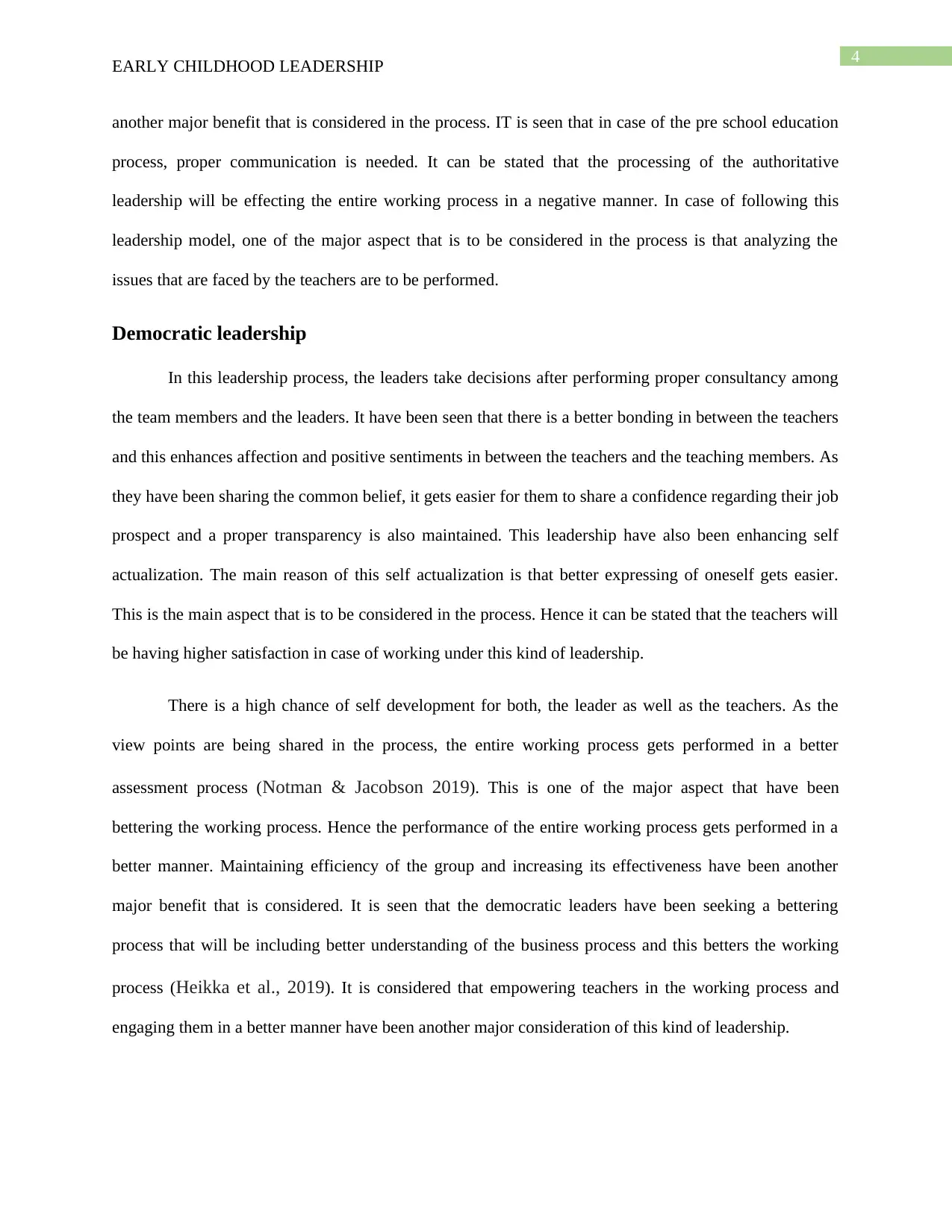
4
EARLY CHILDHOOD LEADERSHIP
another major benefit that is considered in the process. IT is seen that in case of the pre school education
process, proper communication is needed. It can be stated that the processing of the authoritative
leadership will be effecting the entire working process in a negative manner. In case of following this
leadership model, one of the major aspect that is to be considered in the process is that analyzing the
issues that are faced by the teachers are to be performed.
Democratic leadership
In this leadership process, the leaders take decisions after performing proper consultancy among
the team members and the leaders. It have been seen that there is a better bonding in between the teachers
and this enhances affection and positive sentiments in between the teachers and the teaching members. As
they have been sharing the common belief, it gets easier for them to share a confidence regarding their job
prospect and a proper transparency is also maintained. This leadership have also been enhancing self
actualization. The main reason of this self actualization is that better expressing of oneself gets easier.
This is the main aspect that is to be considered in the process. Hence it can be stated that the teachers will
be having higher satisfaction in case of working under this kind of leadership.
There is a high chance of self development for both, the leader as well as the teachers. As the
view points are being shared in the process, the entire working process gets performed in a better
assessment process (Notman & Jacobson 2019). This is one of the major aspect that have been
bettering the working process. Hence the performance of the entire working process gets performed in a
better manner. Maintaining efficiency of the group and increasing its effectiveness have been another
major benefit that is considered. It is seen that the democratic leaders have been seeking a bettering
process that will be including better understanding of the business process and this betters the working
process (Heikka et al., 2019). It is considered that empowering teachers in the working process and
engaging them in a better manner have been another major consideration of this kind of leadership.
EARLY CHILDHOOD LEADERSHIP
another major benefit that is considered in the process. IT is seen that in case of the pre school education
process, proper communication is needed. It can be stated that the processing of the authoritative
leadership will be effecting the entire working process in a negative manner. In case of following this
leadership model, one of the major aspect that is to be considered in the process is that analyzing the
issues that are faced by the teachers are to be performed.
Democratic leadership
In this leadership process, the leaders take decisions after performing proper consultancy among
the team members and the leaders. It have been seen that there is a better bonding in between the teachers
and this enhances affection and positive sentiments in between the teachers and the teaching members. As
they have been sharing the common belief, it gets easier for them to share a confidence regarding their job
prospect and a proper transparency is also maintained. This leadership have also been enhancing self
actualization. The main reason of this self actualization is that better expressing of oneself gets easier.
This is the main aspect that is to be considered in the process. Hence it can be stated that the teachers will
be having higher satisfaction in case of working under this kind of leadership.
There is a high chance of self development for both, the leader as well as the teachers. As the
view points are being shared in the process, the entire working process gets performed in a better
assessment process (Notman & Jacobson 2019). This is one of the major aspect that have been
bettering the working process. Hence the performance of the entire working process gets performed in a
better manner. Maintaining efficiency of the group and increasing its effectiveness have been another
major benefit that is considered. It is seen that the democratic leaders have been seeking a bettering
process that will be including better understanding of the business process and this betters the working
process (Heikka et al., 2019). It is considered that empowering teachers in the working process and
engaging them in a better manner have been another major consideration of this kind of leadership.
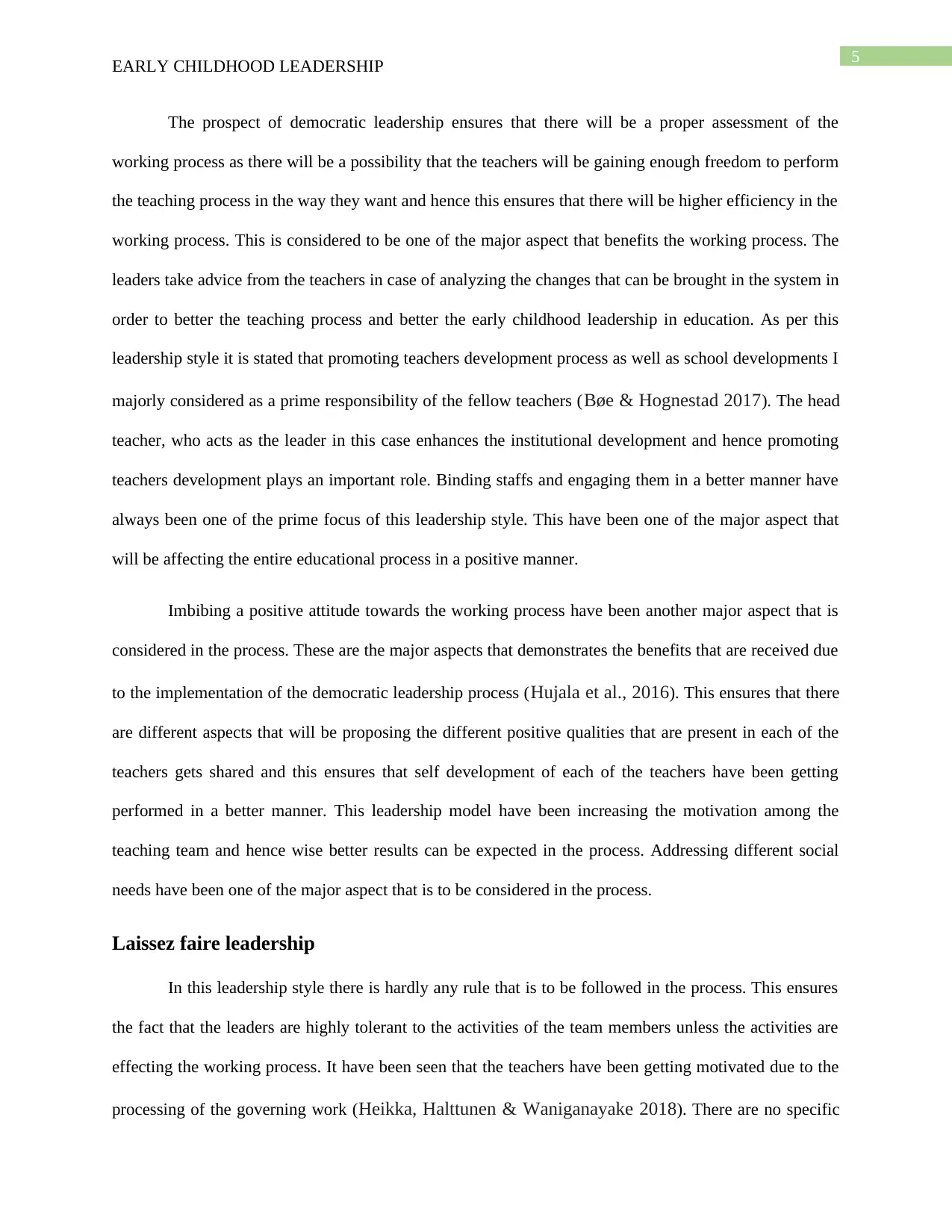
5
EARLY CHILDHOOD LEADERSHIP
The prospect of democratic leadership ensures that there will be a proper assessment of the
working process as there will be a possibility that the teachers will be gaining enough freedom to perform
the teaching process in the way they want and hence this ensures that there will be higher efficiency in the
working process. This is considered to be one of the major aspect that benefits the working process. The
leaders take advice from the teachers in case of analyzing the changes that can be brought in the system in
order to better the teaching process and better the early childhood leadership in education. As per this
leadership style it is stated that promoting teachers development process as well as school developments I
majorly considered as a prime responsibility of the fellow teachers (Bøe & Hognestad 2017). The head
teacher, who acts as the leader in this case enhances the institutional development and hence promoting
teachers development plays an important role. Binding staffs and engaging them in a better manner have
always been one of the prime focus of this leadership style. This have been one of the major aspect that
will be affecting the entire educational process in a positive manner.
Imbibing a positive attitude towards the working process have been another major aspect that is
considered in the process. These are the major aspects that demonstrates the benefits that are received due
to the implementation of the democratic leadership process (Hujala et al., 2016). This ensures that there
are different aspects that will be proposing the different positive qualities that are present in each of the
teachers gets shared and this ensures that self development of each of the teachers have been getting
performed in a better manner. This leadership model have been increasing the motivation among the
teaching team and hence wise better results can be expected in the process. Addressing different social
needs have been one of the major aspect that is to be considered in the process.
Laissez faire leadership
In this leadership style there is hardly any rule that is to be followed in the process. This ensures
the fact that the leaders are highly tolerant to the activities of the team members unless the activities are
effecting the working process. It have been seen that the teachers have been getting motivated due to the
processing of the governing work (Heikka, Halttunen & Waniganayake 2018). There are no specific
EARLY CHILDHOOD LEADERSHIP
The prospect of democratic leadership ensures that there will be a proper assessment of the
working process as there will be a possibility that the teachers will be gaining enough freedom to perform
the teaching process in the way they want and hence this ensures that there will be higher efficiency in the
working process. This is considered to be one of the major aspect that benefits the working process. The
leaders take advice from the teachers in case of analyzing the changes that can be brought in the system in
order to better the teaching process and better the early childhood leadership in education. As per this
leadership style it is stated that promoting teachers development process as well as school developments I
majorly considered as a prime responsibility of the fellow teachers (Bøe & Hognestad 2017). The head
teacher, who acts as the leader in this case enhances the institutional development and hence promoting
teachers development plays an important role. Binding staffs and engaging them in a better manner have
always been one of the prime focus of this leadership style. This have been one of the major aspect that
will be affecting the entire educational process in a positive manner.
Imbibing a positive attitude towards the working process have been another major aspect that is
considered in the process. These are the major aspects that demonstrates the benefits that are received due
to the implementation of the democratic leadership process (Hujala et al., 2016). This ensures that there
are different aspects that will be proposing the different positive qualities that are present in each of the
teachers gets shared and this ensures that self development of each of the teachers have been getting
performed in a better manner. This leadership model have been increasing the motivation among the
teaching team and hence wise better results can be expected in the process. Addressing different social
needs have been one of the major aspect that is to be considered in the process.
Laissez faire leadership
In this leadership style there is hardly any rule that is to be followed in the process. This ensures
the fact that the leaders are highly tolerant to the activities of the team members unless the activities are
effecting the working process. It have been seen that the teachers have been getting motivated due to the
processing of the governing work (Heikka, Halttunen & Waniganayake 2018). There are no specific
⊘ This is a preview!⊘
Do you want full access?
Subscribe today to unlock all pages.

Trusted by 1+ million students worldwide
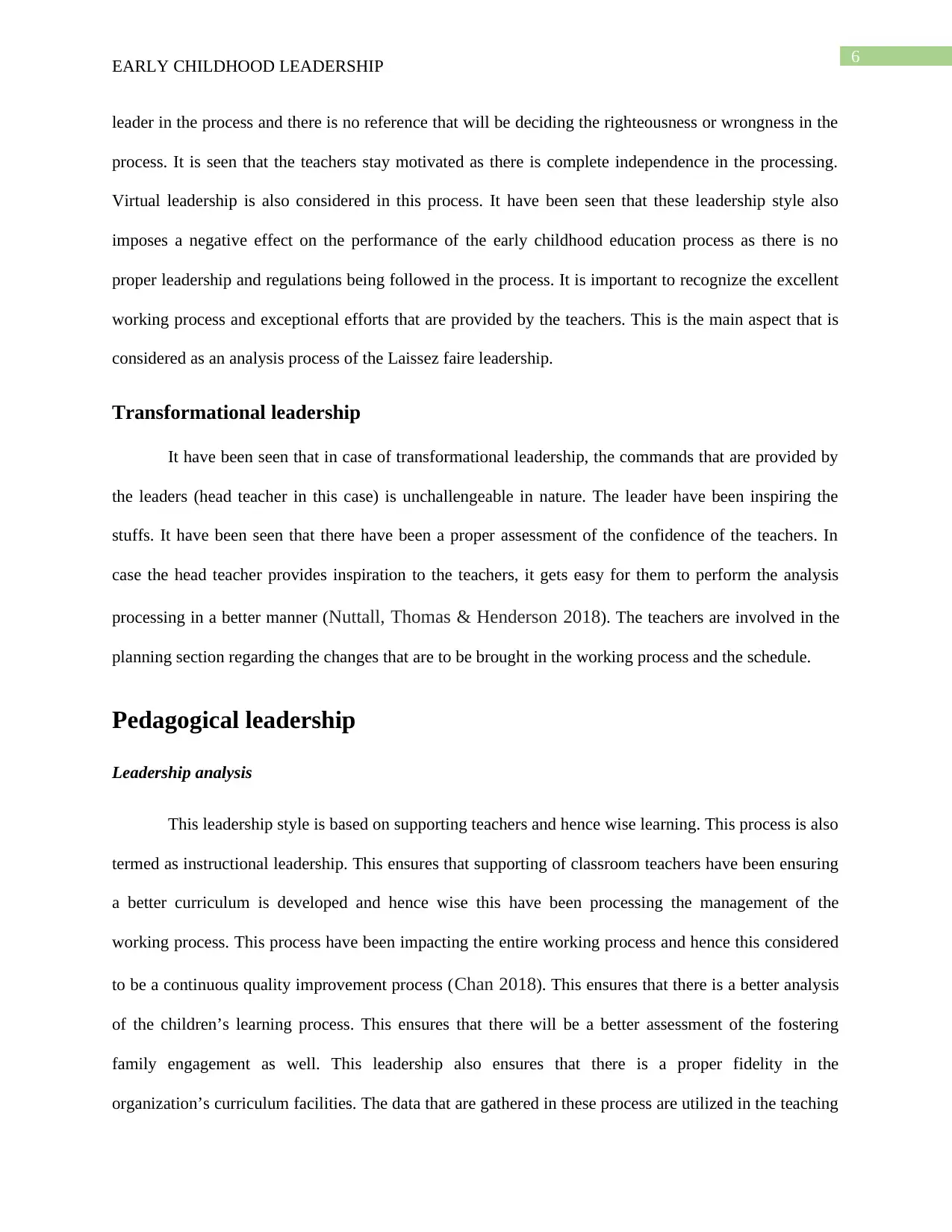
6
EARLY CHILDHOOD LEADERSHIP
leader in the process and there is no reference that will be deciding the righteousness or wrongness in the
process. It is seen that the teachers stay motivated as there is complete independence in the processing.
Virtual leadership is also considered in this process. It have been seen that these leadership style also
imposes a negative effect on the performance of the early childhood education process as there is no
proper leadership and regulations being followed in the process. It is important to recognize the excellent
working process and exceptional efforts that are provided by the teachers. This is the main aspect that is
considered as an analysis process of the Laissez faire leadership.
Transformational leadership
It have been seen that in case of transformational leadership, the commands that are provided by
the leaders (head teacher in this case) is unchallengeable in nature. The leader have been inspiring the
stuffs. It have been seen that there have been a proper assessment of the confidence of the teachers. In
case the head teacher provides inspiration to the teachers, it gets easy for them to perform the analysis
processing in a better manner (Nuttall, Thomas & Henderson 2018). The teachers are involved in the
planning section regarding the changes that are to be brought in the working process and the schedule.
Pedagogical leadership
Leadership analysis
This leadership style is based on supporting teachers and hence wise learning. This process is also
termed as instructional leadership. This ensures that supporting of classroom teachers have been ensuring
a better curriculum is developed and hence wise this have been processing the management of the
working process. This process have been impacting the entire working process and hence this considered
to be a continuous quality improvement process (Chan 2018). This ensures that there is a better analysis
of the children’s learning process. This ensures that there will be a better assessment of the fostering
family engagement as well. This leadership also ensures that there is a proper fidelity in the
organization’s curriculum facilities. The data that are gathered in these process are utilized in the teaching
EARLY CHILDHOOD LEADERSHIP
leader in the process and there is no reference that will be deciding the righteousness or wrongness in the
process. It is seen that the teachers stay motivated as there is complete independence in the processing.
Virtual leadership is also considered in this process. It have been seen that these leadership style also
imposes a negative effect on the performance of the early childhood education process as there is no
proper leadership and regulations being followed in the process. It is important to recognize the excellent
working process and exceptional efforts that are provided by the teachers. This is the main aspect that is
considered as an analysis process of the Laissez faire leadership.
Transformational leadership
It have been seen that in case of transformational leadership, the commands that are provided by
the leaders (head teacher in this case) is unchallengeable in nature. The leader have been inspiring the
stuffs. It have been seen that there have been a proper assessment of the confidence of the teachers. In
case the head teacher provides inspiration to the teachers, it gets easy for them to perform the analysis
processing in a better manner (Nuttall, Thomas & Henderson 2018). The teachers are involved in the
planning section regarding the changes that are to be brought in the working process and the schedule.
Pedagogical leadership
Leadership analysis
This leadership style is based on supporting teachers and hence wise learning. This process is also
termed as instructional leadership. This ensures that supporting of classroom teachers have been ensuring
a better curriculum is developed and hence wise this have been processing the management of the
working process. This process have been impacting the entire working process and hence this considered
to be a continuous quality improvement process (Chan 2018). This ensures that there is a better analysis
of the children’s learning process. This ensures that there will be a better assessment of the fostering
family engagement as well. This leadership also ensures that there is a proper fidelity in the
organization’s curriculum facilities. The data that are gathered in these process are utilized in the teaching
Paraphrase This Document
Need a fresh take? Get an instant paraphrase of this document with our AI Paraphraser
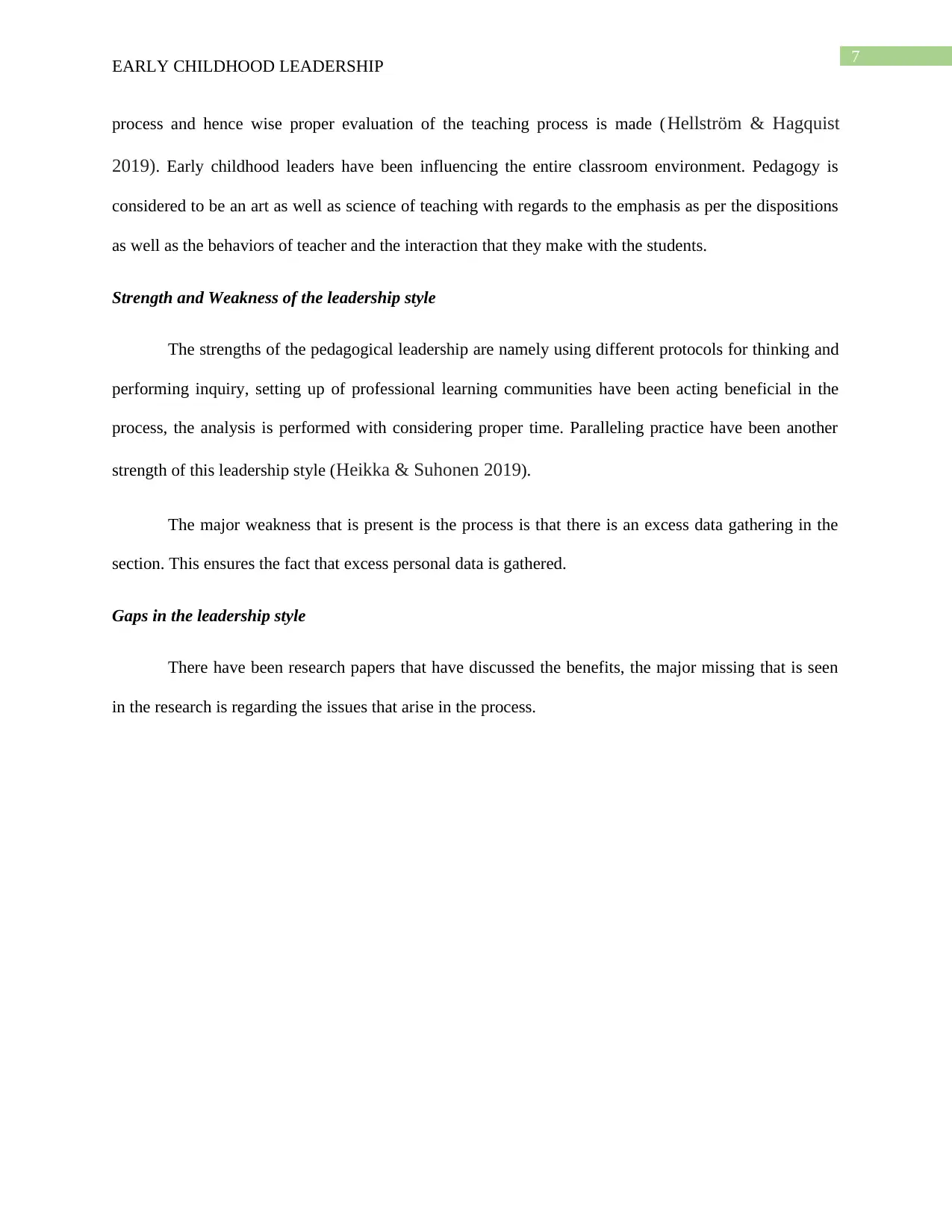
7
EARLY CHILDHOOD LEADERSHIP
process and hence wise proper evaluation of the teaching process is made ( Hellström & Hagquist
2019). Early childhood leaders have been influencing the entire classroom environment. Pedagogy is
considered to be an art as well as science of teaching with regards to the emphasis as per the dispositions
as well as the behaviors of teacher and the interaction that they make with the students.
Strength and Weakness of the leadership style
The strengths of the pedagogical leadership are namely using different protocols for thinking and
performing inquiry, setting up of professional learning communities have been acting beneficial in the
process, the analysis is performed with considering proper time. Paralleling practice have been another
strength of this leadership style (Heikka & Suhonen 2019).
The major weakness that is present is the process is that there is an excess data gathering in the
section. This ensures the fact that excess personal data is gathered.
Gaps in the leadership style
There have been research papers that have discussed the benefits, the major missing that is seen
in the research is regarding the issues that arise in the process.
EARLY CHILDHOOD LEADERSHIP
process and hence wise proper evaluation of the teaching process is made ( Hellström & Hagquist
2019). Early childhood leaders have been influencing the entire classroom environment. Pedagogy is
considered to be an art as well as science of teaching with regards to the emphasis as per the dispositions
as well as the behaviors of teacher and the interaction that they make with the students.
Strength and Weakness of the leadership style
The strengths of the pedagogical leadership are namely using different protocols for thinking and
performing inquiry, setting up of professional learning communities have been acting beneficial in the
process, the analysis is performed with considering proper time. Paralleling practice have been another
strength of this leadership style (Heikka & Suhonen 2019).
The major weakness that is present is the process is that there is an excess data gathering in the
section. This ensures the fact that excess personal data is gathered.
Gaps in the leadership style
There have been research papers that have discussed the benefits, the major missing that is seen
in the research is regarding the issues that arise in the process.
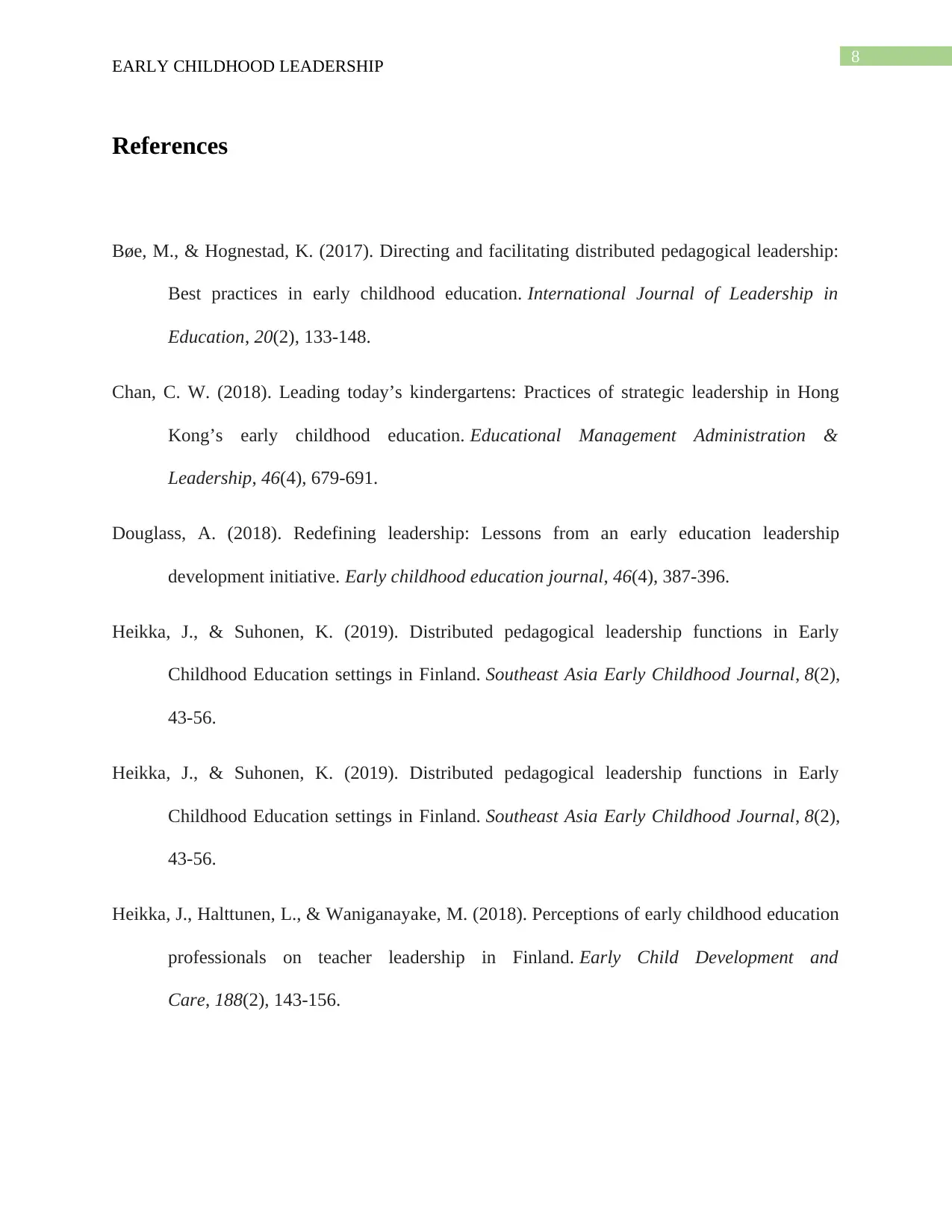
8
EARLY CHILDHOOD LEADERSHIP
References
Bøe, M., & Hognestad, K. (2017). Directing and facilitating distributed pedagogical leadership:
Best practices in early childhood education. International Journal of Leadership in
Education, 20(2), 133-148.
Chan, C. W. (2018). Leading today’s kindergartens: Practices of strategic leadership in Hong
Kong’s early childhood education. Educational Management Administration &
Leadership, 46(4), 679-691.
Douglass, A. (2018). Redefining leadership: Lessons from an early education leadership
development initiative. Early childhood education journal, 46(4), 387-396.
Heikka, J., & Suhonen, K. (2019). Distributed pedagogical leadership functions in Early
Childhood Education settings in Finland. Southeast Asia Early Childhood Journal, 8(2),
43-56.
Heikka, J., & Suhonen, K. (2019). Distributed pedagogical leadership functions in Early
Childhood Education settings in Finland. Southeast Asia Early Childhood Journal, 8(2),
43-56.
Heikka, J., Halttunen, L., & Waniganayake, M. (2018). Perceptions of early childhood education
professionals on teacher leadership in Finland. Early Child Development and
Care, 188(2), 143-156.
EARLY CHILDHOOD LEADERSHIP
References
Bøe, M., & Hognestad, K. (2017). Directing and facilitating distributed pedagogical leadership:
Best practices in early childhood education. International Journal of Leadership in
Education, 20(2), 133-148.
Chan, C. W. (2018). Leading today’s kindergartens: Practices of strategic leadership in Hong
Kong’s early childhood education. Educational Management Administration &
Leadership, 46(4), 679-691.
Douglass, A. (2018). Redefining leadership: Lessons from an early education leadership
development initiative. Early childhood education journal, 46(4), 387-396.
Heikka, J., & Suhonen, K. (2019). Distributed pedagogical leadership functions in Early
Childhood Education settings in Finland. Southeast Asia Early Childhood Journal, 8(2),
43-56.
Heikka, J., & Suhonen, K. (2019). Distributed pedagogical leadership functions in Early
Childhood Education settings in Finland. Southeast Asia Early Childhood Journal, 8(2),
43-56.
Heikka, J., Halttunen, L., & Waniganayake, M. (2018). Perceptions of early childhood education
professionals on teacher leadership in Finland. Early Child Development and
Care, 188(2), 143-156.
⊘ This is a preview!⊘
Do you want full access?
Subscribe today to unlock all pages.

Trusted by 1+ million students worldwide
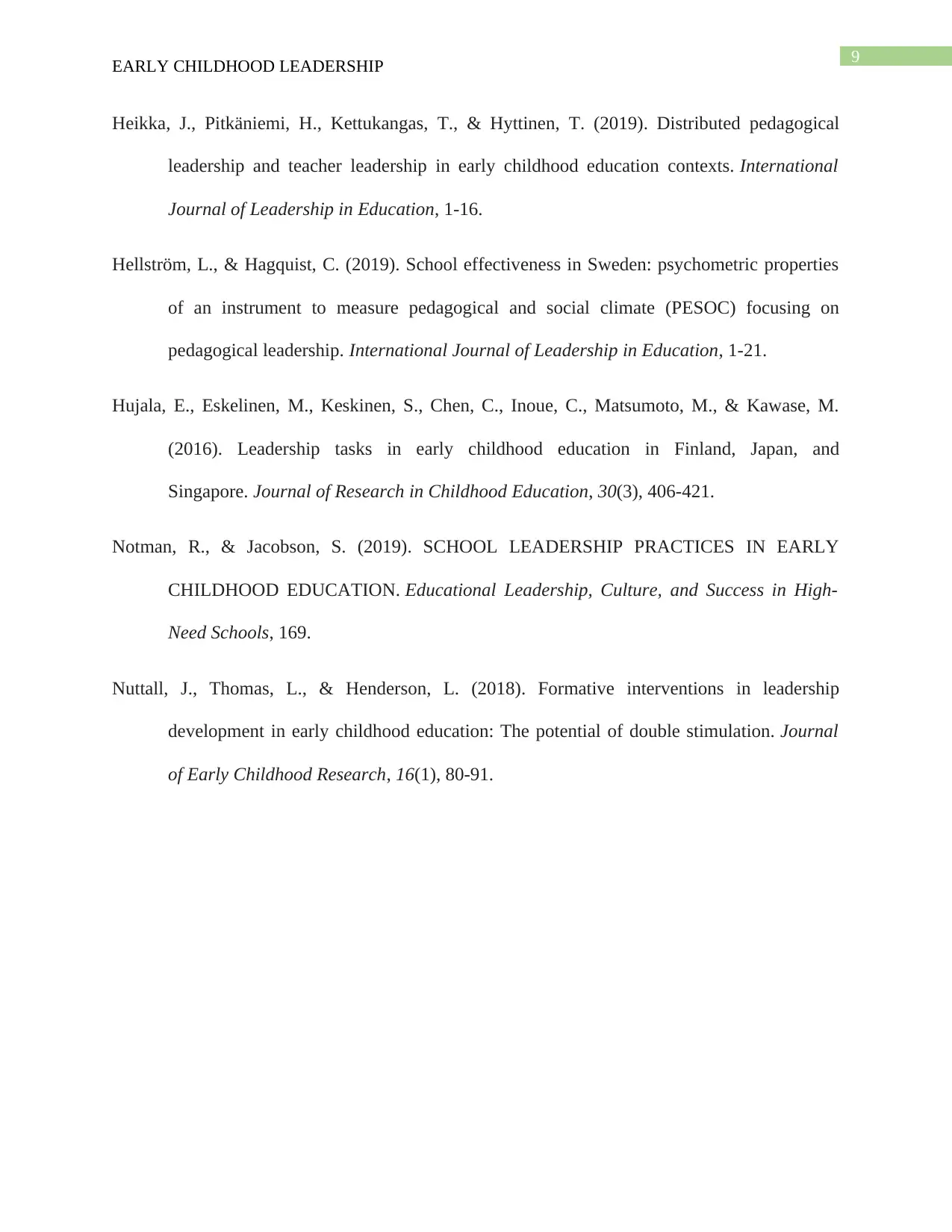
9
EARLY CHILDHOOD LEADERSHIP
Heikka, J., Pitkäniemi, H., Kettukangas, T., & Hyttinen, T. (2019). Distributed pedagogical
leadership and teacher leadership in early childhood education contexts. International
Journal of Leadership in Education, 1-16.
Hellström, L., & Hagquist, C. (2019). School effectiveness in Sweden: psychometric properties
of an instrument to measure pedagogical and social climate (PESOC) focusing on
pedagogical leadership. International Journal of Leadership in Education, 1-21.
Hujala, E., Eskelinen, M., Keskinen, S., Chen, C., Inoue, C., Matsumoto, M., & Kawase, M.
(2016). Leadership tasks in early childhood education in Finland, Japan, and
Singapore. Journal of Research in Childhood Education, 30(3), 406-421.
Notman, R., & Jacobson, S. (2019). SCHOOL LEADERSHIP PRACTICES IN EARLY
CHILDHOOD EDUCATION. Educational Leadership, Culture, and Success in High-
Need Schools, 169.
Nuttall, J., Thomas, L., & Henderson, L. (2018). Formative interventions in leadership
development in early childhood education: The potential of double stimulation. Journal
of Early Childhood Research, 16(1), 80-91.
EARLY CHILDHOOD LEADERSHIP
Heikka, J., Pitkäniemi, H., Kettukangas, T., & Hyttinen, T. (2019). Distributed pedagogical
leadership and teacher leadership in early childhood education contexts. International
Journal of Leadership in Education, 1-16.
Hellström, L., & Hagquist, C. (2019). School effectiveness in Sweden: psychometric properties
of an instrument to measure pedagogical and social climate (PESOC) focusing on
pedagogical leadership. International Journal of Leadership in Education, 1-21.
Hujala, E., Eskelinen, M., Keskinen, S., Chen, C., Inoue, C., Matsumoto, M., & Kawase, M.
(2016). Leadership tasks in early childhood education in Finland, Japan, and
Singapore. Journal of Research in Childhood Education, 30(3), 406-421.
Notman, R., & Jacobson, S. (2019). SCHOOL LEADERSHIP PRACTICES IN EARLY
CHILDHOOD EDUCATION. Educational Leadership, Culture, and Success in High-
Need Schools, 169.
Nuttall, J., Thomas, L., & Henderson, L. (2018). Formative interventions in leadership
development in early childhood education: The potential of double stimulation. Journal
of Early Childhood Research, 16(1), 80-91.
1 out of 10
Related Documents
Your All-in-One AI-Powered Toolkit for Academic Success.
+13062052269
info@desklib.com
Available 24*7 on WhatsApp / Email
![[object Object]](/_next/static/media/star-bottom.7253800d.svg)
Unlock your academic potential
Copyright © 2020–2025 A2Z Services. All Rights Reserved. Developed and managed by ZUCOL.




